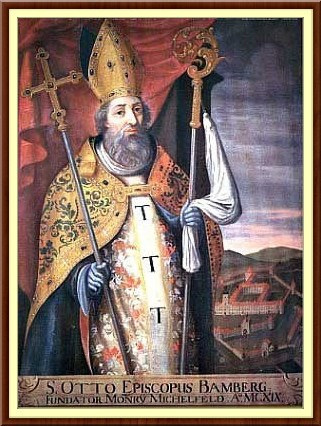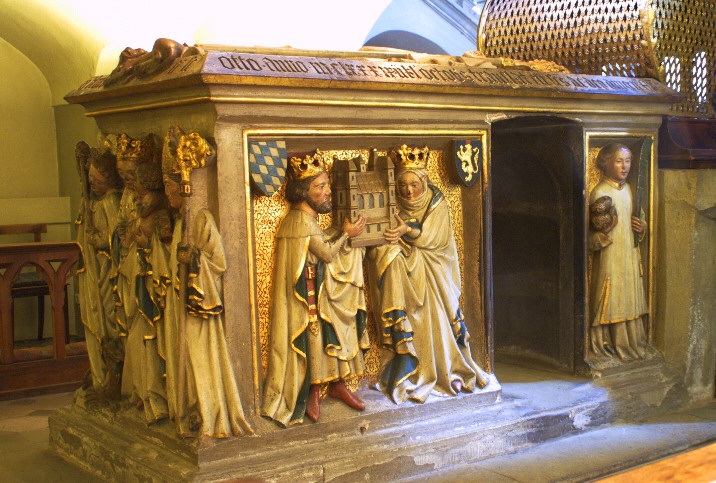Adapted from Various Sources.
St. Otto, Bishop of Bamberg and Apostle of Pomerania († 1139; Feast – July 2)
 St. Otto was a native of Schwabia in Germany, and being a cleric eminent for piety and learning, was chosen by the Emperor Henry IV to
attend to his sister Judith in the quality of chaplain, when she was married to Boleslas III, Duke of Poland (that country being
deprived of the royal dignity from 1079, after King Boleslas II was sent into exile on account of having ordered the martyrdom of
St. Stanislas of Cracow. There were no kings permitted to Poland until the coronation of Premislas II in 1295.) After the death
of Princess Judith, Otto returned to Germany and was made chancellor by Henry IV. That Emperor caused the seals and crosses of
every deceased bishop and great abbot to be delivered to him, and he sold them to whom he pleased. This notorious simony and
oppression of the Church was zealously condemned by the Pope (St. Gregory VII), in opposition to whom the Emperor set up the antipope
Gilbert (the Archbishop of Ravenna, who took the name of Clement III).
St. Otto was a native of Schwabia in Germany, and being a cleric eminent for piety and learning, was chosen by the Emperor Henry IV to
attend to his sister Judith in the quality of chaplain, when she was married to Boleslas III, Duke of Poland (that country being
deprived of the royal dignity from 1079, after King Boleslas II was sent into exile on account of having ordered the martyrdom of
St. Stanislas of Cracow. There were no kings permitted to Poland until the coronation of Premislas II in 1295.) After the death
of Princess Judith, Otto returned to Germany and was made chancellor by Henry IV. That Emperor caused the seals and crosses of
every deceased bishop and great abbot to be delivered to him, and he sold them to whom he pleased. This notorious simony and
oppression of the Church was zealously condemned by the Pope (St. Gregory VII), in opposition to whom the Emperor set up the antipope
Gilbert (the Archbishop of Ravenna, who took the name of Clement III).
St. Otto labored to bring his Emperor to sentiments of repentance and submission, and refused to approve his schism and
other crimes. Nevertheless, so great was the esteem which the Emperor had for his virtue, that – resolving to make choice of at
least one good bishop – he nominated him to become Bishop of Bamberg in 1103. The Saint, in spite of the schism, went to Rome and
received confirmation of his election and the archbishop's pallium from Pope Paschal II. St. Otto labored to extinguish the schism
and to obviate the mischief which it produced; and for this purpose he displayed his eloquence and abilitities in the Diet at Ratisbon
in 1104.
Henry V, succeeding his father in 1106, continued to foment the schism; yet he inherited the esteem of his predecessor
for our Saint, though Otto always adhered to the Holy See and was in the highest credit with all the true Popes of his time –
so strongly does virtue command respect even in its adversaries, and such is the power of meekness in disarming the fiercest tyrants.
St. Otto joined always with the functions of his office the exercises of the interior life, in which his proficiency was admirable.
He made many pious foundations, calling them inns which we erect on our road to eternity.
Boleslas IV, Duke of Poland, son of that Boleslas who had married the sister of Henry IV, having succeeded his elder
brother Ladislas II and conquered Pomerania, entreated St. Otto to undertake a mission among the idolaters of that country.
(Pomerania is a region along the southern coast of the Baltic Sea, and is split between modern-day Germany and Poland. In St. Otto's
time it was to the west of Prussia, to the northwest of Poland, and to the east of Saxony.) The saintly Bishop, having settled his
own diocese in good order, and obtained from Pope Honorius II a commission for that purpose, took with him a considerable number of
zealous priests and catechists, and passed through Poland into Prussia, and thence into eastern Pomerania.
He was met by Wratislav II, Duke of Upper Pomerania, who received the Sacrament of Baptism with the greater part of his
people in 1124. St. Otto returned to Bamberg for Easter the following year, having appointed priests everywhere to attend to the new
converts, and finish the work he had so happily begun. The towns of Stettin and Julin (now called Wolin) having again relapsed
into idolatry, St. Otto, with a second blessing from Pope Honorius II, returned into Pomerania in 1128, brought those cities back to
the Faith, and through innumerable hardships and dangers carried the light of the Gospel into other remote barbarous provinces.
He returned again to the care of his own flock in Bamberg, amidst which he died the death of the Saints on June 30, 1139.
He was buried at Kloster Michaelsberg on July 2, on which day he is commemorated in the Roman Martyrology. He was canonized by Pope
Clement III in 1189.

Back to "In this Issue"
Back to Top
Back to Saints
Alphabetical Index; Calendar List of Saints
Contact us: smr@salvemariaregina.info
Visit also: www.marienfried.com


 St. Otto was a native of Schwabia in Germany, and being a cleric eminent for piety and learning, was chosen by the Emperor Henry IV to
attend to his sister Judith in the quality of chaplain, when she was married to Boleslas III, Duke of Poland (that country being
deprived of the royal dignity from 1079, after King Boleslas II was sent into exile on account of having ordered the martyrdom of
St. Stanislas of Cracow. There were no kings permitted to Poland until the coronation of Premislas II in 1295.) After the death
of Princess Judith, Otto returned to Germany and was made chancellor by Henry IV. That Emperor caused the seals and crosses of
every deceased bishop and great abbot to be delivered to him, and he sold them to whom he pleased. This notorious simony and
oppression of the Church was zealously condemned by the Pope (St. Gregory VII), in opposition to whom the Emperor set up the antipope
Gilbert (the Archbishop of Ravenna, who took the name of Clement III).
St. Otto was a native of Schwabia in Germany, and being a cleric eminent for piety and learning, was chosen by the Emperor Henry IV to
attend to his sister Judith in the quality of chaplain, when she was married to Boleslas III, Duke of Poland (that country being
deprived of the royal dignity from 1079, after King Boleslas II was sent into exile on account of having ordered the martyrdom of
St. Stanislas of Cracow. There were no kings permitted to Poland until the coronation of Premislas II in 1295.) After the death
of Princess Judith, Otto returned to Germany and was made chancellor by Henry IV. That Emperor caused the seals and crosses of
every deceased bishop and great abbot to be delivered to him, and he sold them to whom he pleased. This notorious simony and
oppression of the Church was zealously condemned by the Pope (St. Gregory VII), in opposition to whom the Emperor set up the antipope
Gilbert (the Archbishop of Ravenna, who took the name of Clement III).
